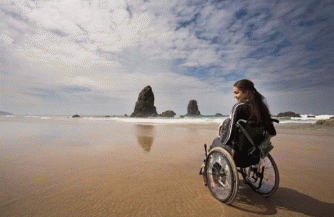ENAT Highlights Need for UNWTO Associates to Develop Their Accessible Tourism Policies
Share on social media
Madrid, Spain. 28 March 2011. Accessible tourism and the increasing demand for it, were among the topics discussed by ENAT (European Network for Accessible Tourism) with the UNWTO's "platma" team, during their recent visit to UNWTO Headquarters in Madrid.
 Madrid, Spain. 28 March 2011.
Madrid, Spain. 28 March 2011.
Accessible tourism and the increasing demand for it, were among the topics discussed by ENAT (European Network for Accessible Tourism) with the UNWTO's "platma" team, during their recent visit to UNWTO Headquarters in Madrid.
platma interviews Ivor Ambrose, expert on accessible tourism
According to the UN Convention on Rights of Persons with Disabilities, access to tourism is a right for everyone. The Convention was signed by 140 countries; however there is still a considerable gap between access needs and the solutions offered by destinations.
This is a constantly growing market, estimated to represent around 130 million people in Europe alone with annual potential spending of around 68 billion Euros. These figures cannot be ignored by the tourism industry, since the lack of adequate facilities for disabled travellers means that many people cannot travel and this can have a huge negative impact on businesses and communities.
 What areas still need to be improved?
What areas still need to be improved?
According to Mr. Ivor Ambrose, Managing Director of ENAT, accessible tourism is about making the whole tourism experience inclusive and accessible to all visitors.
Therefore it is important to address all aspects of the tourism value chain, to meet the needs of the wide range of target groups.
- Information for customers, (on-line, printed and at the venue) should be accessible, e.g. Web sites conforming to Accessibility Guidelines by W3C-WAI.
- Transport and transfers must be accessible for all travellers throughout the journey; this should include the provision of wheelchair accessible transport.
- Infrastructure - all buildings and outdoor environments should be designed and maintained in a way that makes them accessible and usable by all visitors.
- Services – including activities and excursions offered at destinations and venues, should be accessible; e.g. tourist guides, waiter service, cultural tours, festivals and events, also very important - emergency evacuation procedures.
Are organizations and destination management offices including specific policies about accessible tourism in their promotion campaigns?
Some are but most are not! The subject of accessibility has been addressed as a requirement of disabled people in relation to education, employment and access to the built environment for many years but the tourism sector in most countries has not taken up the challenges, at least not in systematic and decisive always, until recently.
Our experience in Europe shows that policies for enabling better access to tourism have moved forward in many countries, incrementally, but have not been coordinated or sustained over the long term.
We are still at a point of development where countries can be “early adopters” of accessible tourism policies and gain advantages over those who have not started to modify and improve their policies and practices in this area.
What type of policies?
Destination management policies. Information and support programmes for tourist enterprises to adapt their premises and offers.
Which factors have contributed to this market’s expansion?
The ageing population demographic in developed economies has drawn attention to the growing market of older tourists. This market segment typically spends more than average and also includes a higher number of persons with impairments or health conditions, which need to be considered by tourism providers.
Major sporting events such as the Olympic and Paralympic Games have obliged host countries to improve accessibility for tourists.
Social Tourism has also played a role in widening the availability of tourism to marginalized groups, and includes holidays for disabled people.
The availability of high quality accessible tourism in some destinations such as Tenerife, and consequent market advantages has spurred others to follow these examples.
 This article was first published on the UNWTO's platma website - the online communication portal for the community of UNWTO Affiliate Members. Used with permission.
This article was first published on the UNWTO's platma website - the online communication portal for the community of UNWTO Affiliate Members. Used with permission.
 The UNWTO is an Honorary Associate Member of ENAT
The UNWTO is an Honorary Associate Member of ENAT
